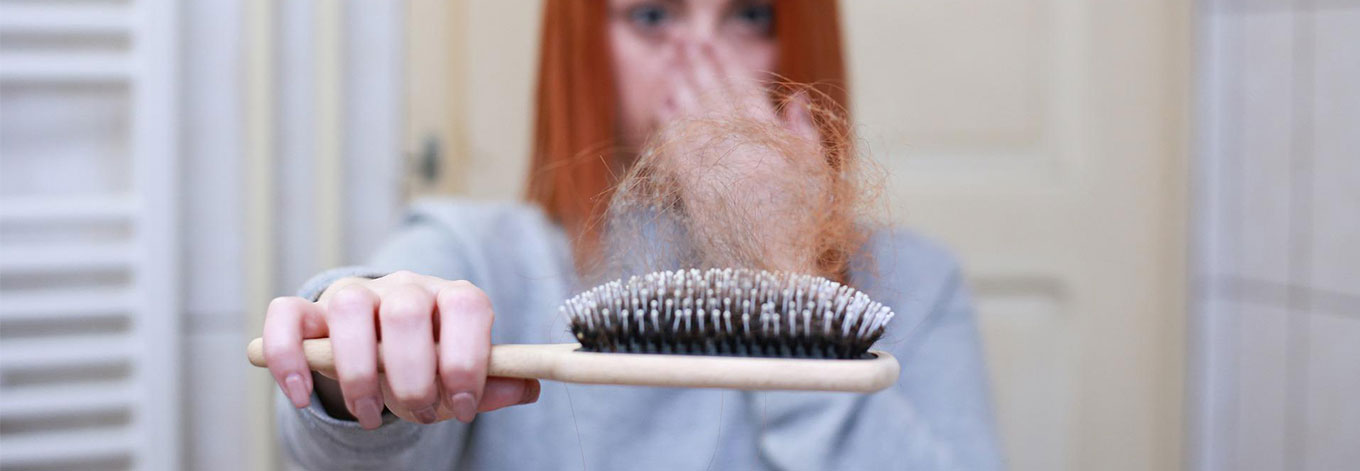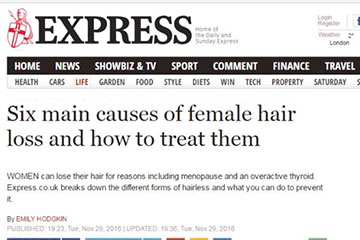
- Female hair loss affects 1 in 5 women.
- We can help to find the cause of your hair loss and put together a bespoke treatment plan to suit your requirements.
What’s on this page
Medically reviewed by Lorcan Sheppard BSc MBBS FRCA, Chief Medical Officer and the Medical Advisory Committee for The Private Clinic.
Last Reviewed September 7th 2022
Related treatments
Female Hair Loss & Thinning
A woman’s hair can feel like her crowning glory. If hair begins to fall out, it isn’t just the individual strands we lose. Some people can find it devastating causing low self-esteem.
What is female hair loss?
Hair shedding for females is very normal and overall, we shed between 50 and 100 single hairs each day. When you begin to experience more unexpected and excessive loss of hair this is different to normal hair shedding and you may begin to notice areas of thinning or loss.
With the average female spending up to £40,000 and over two years’ worth of maintenance on their hair in her lifetime, it’s an important part of a woman’s appearance, so parting with it is not an easy process, so what can be done?
What causes female hair loss?
There can be several reasons why a female is experiencing hair loss. These include:
- Lack of adequate nutrition and vitamins
- Stress
- Traction alopecia
- Immunological conditions (such as alopecia)
- Hormonal imbalances (menstrual, perimenopause and menopause)
- Overuse of hair dryers, hot irons and hair dye
- Illness
What are the different types of female hair loss?
- Anagen Effluvium – This is when hair loss is caused by medication, infection, toxin, radiation or an autoimmune disease which causes damage to the hair follicle. Anagen Effluvium hair loss can be caused by Chemotherapy, radiation therapy and medications such as Colchicine.
- Telogen effluvium – This occurs when there is a larger number of hair follicles reaching the telogen phase at the same time. This can often be a result of stress, shock or a traumatic event. In most cases, once the event has passed then regrowth will occur but recurrent telogen effluvium can often turn into female pattern hair loss. Telogen Effluvium can be caused by childbirth, anaemia, mental illness, abnormal thyroid and menopause.
- Female Androgenetic Alopecia/Female Pattern Hair Loss – This is a distinctive form of female hair loss and usually involves hair thinning across the top and sides of the head. The cause of female androgenetic alopecia is unclear although thoughts are it may be genetic or due to hormonal changes when ageing or menopause.
- Alopecia Areata – This is an inflammatory reaction where your immune system attacks the roots of your hair follicles. This is usually a temporary condition and most cases of it will clear up on their own within two years. It is not known what causes alopecia areata but it is thought to be down to having a genetic predisposition to the disease. In extreme cases, alopecia areata can persist for many years and the hair may never grow back naturally.
- Traction Alopecia – This is when localised trauma is inflicted on the hair follicles caused by the hair being repeatedly pulled tight, usually as a result of tight hairstyles, hair extensions and braiding. Early detection often means traction alopecia can be reversed and hair can regrow when the hair is no longer pulled back. In extreme cases, the hair follicles can become severely damaged and scarred and therefore unable to produce new hair naturally.
Can you treat Female Hair Loss?
Treatment for female hair loss needs to be targeted and completely individual to the specific diagnosis and any scalp issues that may be triggering the hair loss. Over-the-counter shampoos and products can promise to restore hair or add volume but if you do not know the underlying reasons for the hair loss then it is likely to occur again.
There are many ways to treat female hair loss. This can include the use of topical creams and shampoos such as minoxidil, hormonal treatment, light therapy, vitamins, and mineral replacement, changing diet and possibly a hair transplant. But finding the underlying issue is crucial.
It is important to meet with the correct experts in hair restoration for women before you decide to go ahead with any form of hair loss treatment.
Our expert team of hair loss experts are here to help you understand the cause of your hair loss and find the best way forward for you.
Start your journey to regain your hair with consultations available in London Harley Street.
Ask us a question
What to Expect
Consultation
Many women can disguise their hair loss by styling their hair differently but for widespread thinning, this can become noticeable and harder to hide.
When you book a consultation to see one of our experts, you will have a full and detailed examination to allow them to assess what the cause of hair loss may be.
You may be required to do some tests to help further diagnose the source of hair loss which may include:
- Hair Shedding Analysis
- Scalp Evaluation
- Blood Tests
- Scalp Biopsy
You may then also be asked some lifestyle, medical and observational questions such as:
- How do you style your hair?
- What products are you using on your hair?
- What types of food are you eating?
- Has anyone in your family experienced hair loss?
- Is there anything stressful going on in your life?
- Are you taking any medication?
- How long have you been experiencing hair loss?
Once the cause of hair loss has been established, you will be provided with a personalised treatment plan to first help reduce hair loss and thinning and then encourage regrowth.

Female Hair Loss Treatment Options
Calecim Hair Loss Treatment
Calecim is a revolutionary hair loss treatment that uses growth factors to enhance hair growth and fuller-looking hair by activating dormant hair follicles. The treatment involves the Calecim serum being infused into the scalp with a microneedling device. The serum contains a combination of key proteins and growth factors that will help weak and struggling hair follicles. A course of treatment is required for the best results. Find out more.
Minoxidil
You may be recommended to try medication such as Minoxidil which is the only FDA-approved drug to treat female pattern baldness. Minoxidil works to reduce or stop hair loss by prolonging the growth phase of the hair follicles whilst also encouraging new hair to grow. It is a topical medication that needs to be applied directly to the head/scalp daily. Results are usually noticed after 1-2 months of usage but if you decide to stop using minoxidil then there is a risk of hair loss returning.
Corticosteroid
When an autoimmune disease like alopecia areata causes hair loss, you may be prescribed corticosteroid medications. The medications work by acting as immune system suppressors to counteract the effects of the autoimmune disease, this then allows the hair to grow. Corticosteroid treatment may be topical or injected.
Supplements
In instances where nutritional deficiency is the likely cause of hair loss, you will be recommended to improve your diet or to take supplements such as vitamin D, vitamin B, zinc, iron, biotin, or a multivitamin to help improve hair loss.
Non-Surgical Hair Loss Treatment
Non-surgical hair loss treatment uses a substance found within your blood with high levels of proteins known as growth factors. These growth factors are typically associated with wound healing but it has been discovered that when the growth factors are administered in high concentrations, they can be effective at encouraging the growth of dormant hair follicles.
The treatment is carried out in the clinic and involves taking a blood sample which is then placed in a centrifuge to spin the blood, separating the red blood cells and blood plasma.
The blood plasma is then injected into the scalp which causes platelet activation. The platelets release growth factors which then work to stimulate the hair follicles, improve blood circulation and improve the quality of hair follicles which all encourage hair growth.
There is no major downtime involved with non-surgical hair loss treatment. Some mild swelling, redness and bruising may be noticeable for 24-48 hours. Results are best seen after a course of 3-6 treatments which should be spread out over 3-6 months.
Female Hair Transplant
A hair transplant is a permanent treatment that takes healthy hair from the back of your head and implants it into areas of hair loss or thinning to improve the thickness of the hair.
A hair transplant should only be carried out by a hair transplant surgeon who is experienced in female hair transplants. Female hair transplantation is a specialised procedure that requires a great amount of skill to get a natural result.
Results
Unfortunately, hair grows slowly, so it will take time to see results from any type of female hair loss treatment, lifestyle changes or medication.
If you are taking minoxidil, you may start to notice improvements to your hair quality after 1-2 months but overall it takes around a year before the best results are seen.
Non-Surgical Hair Loss treatment requires a course of 3-6 treatments and results are best seen after 3-6 months following your course of treatment. Click here to find out more about Non-Surgical Hair Loss treatment and see before and after photos.
Calecim Hair Loss Treatment requires a course of that are performed once a week for 6 weeks. In more severe hair loss cases, a course of 12 treatments may be recommended. The results from Calecim treatment can start to be seen from 5 to 6 weeks when new vellus hairs may be visible.
Our experts offer follow-up appointments to assess the results of your female hair loss treatments, medication or lifestyle changes and will continue to offer their support where required.
If you decide to undergo a female hair transplant procedure it can take 6-12 months before you can see the results. Click here to find out more about female hair transplants and see before and after results.
Frequently Asked Questions
There are lots of ways to treat or at least reduce female hair loss.
Our team of expert Trichologists are very knowledgeable and will be able to firstly diagnose what may be causing your hair loss before then offering a range of different treatment options to help manage hair loss.
Our treatments include:
- Lifestyle and Dietary changes
- Supplements
- Medication
- Non-Surgical Hair Loss Treatment
- Hair Transplant for Women
Book a consultation to find which treatment would be best suited to you.
The progression of hair loss in women will vary from person to person depending on the cause of the hair loss.
For female pattern baldness, the hair loss process is not constant and usually occurs in fits and bursts where you may notice severe loss for 3-6 months followed by 6 months of stability. If you are not treating the female pattern hair loss then it will progress in severity over the years.
Telogen effluvium hair loss usually occurs 3 months after a stressful event and can last for up to 6 months.
Anagen effluvium hair loss can take place within 14 days of administration of the offending drug. Hair loss will continue whilst the medication or treatments are being carried out. Hair may start growing back at any time, usually when the drugs or treatments causing the hair loss have been stopped.
Anagen effluvium hair loss is caused by medication, infection, toxin, radiation or an autoimmune disease damaging the hair follicles. This causes sudden hair loss which can happen anywhere on your body, not just your scalp. Sometimes, anagen effluvium hair loss can be permanent but usually hair growth is able to return once the source of the damage is stopped.
Causes include:
- Chemotherapy
- Radiation Therapy
- Certain Medications
- Alopecia Areata
- Fungal hair infections
- Heavy metal intoxication
- Ingestion of toxins or exposure to toxins
- Loose anagen syndrome
- Trichotillomania
- Discoid lupus erythematosus
- Pemphigus Vulgaris
Telogen effluvium occurs when there are increased proportions of hairs shifting from the growing phase (anagen) to the shedding phase (telogen). This results in a distinct increase in the number of hairs shed each day. Telogen effluvium often resolves completely without any treatment over several months as long as the cause has been managed.
Causes include:
- Extreme weight loss
- Post-Surgery
- Anaemia
- Severe trauma or illness
- Childbirth
- Mental Illness
- Bereavement
- Abnormal Thyroid
- High doses of vitamin A
- Blood pressure medication
- Menopause
- Birth Control Pills
Female pattern hair loss is a progressive hair loss condition that is the most common form of hair loss in women. It is said to have a strong genetic predisposition which means it is likely to be passed down genetically from one or both parents. It is also known to be more common after menopause which suggests hormone levels such as oestrogen may impact the development of female pattern baldness.
Female hair loss treatment is Available in these Clinics
Why Choose The Private Clinic
- Expert medical practitioners with years of experience.
- State of the art medical facilities, all registered by the CQC (Care Quality Commission).
- Our innovative treatment choice means you will be offered the most advanced minimally invasive treatment options.
- When it comes to non-surgical treatments we always strive to give you little to no downtime, so you can get back to enjoying life.












